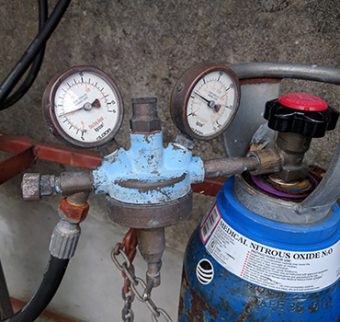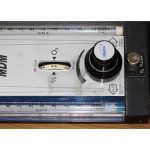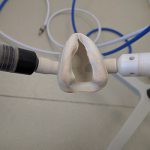Dental staff training for inhalation sedation
Over the last few years, there have been several articles written about the equipment used for inhalation sedation (IS), or relative analgesia as it is still occasionally referred to. However, there has been little about the training requirements and problems encountered where insufficient training may take place.
For some time, it has become increasingly evident that certain elements of training in inhalation sedation for all levels of dental professionals can be lacking, with some vital areas either being incompletely taught or missed out altogether.
This includes such topics as:
- Inability to identify and name the type of sedation equipment in use i.e. differing manufacturer/machine types
- Not able to identify or name the type of breathing delivery system in use or understand the varying components and how they interface – or even how to assemble it
- Ignorance of medical gas cylinders – handling, storage etc. This area often seems to be omitted from teaching
- Dental scavenging – a misunderstood area and the most dangerous one to be ignorant about in terms of the damage that can be caused by inappropriate cleaning methods.
The underlying basis for the above could well be twofold: syllabus content and the method of training employed. Training for undergraduate/postgraduate dentists varies significantly depending on where the training originates. Similarly, dental nurses are also subject to a great level of variation. The NEBDN syllabus, Training in Conscious Sedation for Dental Nurses (Ref. 1), is designed to cover all methods of sedation, not just inhalational. However, it is now possible to train in just IS, although, like dentists, they are subject to variable levels of training, some excellent, others much less so.
The syllabus employed by both sectors, while theoretically listing most of the functionality staff should display once trained, is extremely dependant on the actual teaching of such to ensure competency. As provision of this varies widely, staff have been displaying knowledge deficiency in even some of the most basic areas, leading to equipment usage problems.
This is as a direct result of the inequality of some training and causes inappropriate or misuse of sedation equipment and scavenging of exhaled gas, an unfortunate situation and one that should be remedied as quickly as possible. It is not perceived as a direct fault of the dental staff themselves, but more as a direct result of the training deficiencies.
It is not sufficient to revise the syllabus – the whole issue of training and how this is conducted should also be subject to scrutiny.
Any training should include the following modules:
- Identification of all current IS equipment e.g. MDM, MXR etc. This section should also include a guide of how to identify older units that may now be obsolete, or soon to be, due to age/condition
- Understand the variety of mounting options available for each type of flowmeter and how they would provide the medical gas supply, or interface with it
- Breathing systems and nasal masks. Staff need to know what type of breathing circuits are available for dental sedation and which type of nasal mask can be used with each. They should also be taught regarding older types which technically are obsolete, but remain in use at some teaching establishments, i.e. the passive (not to be confused with another form of passive gas scavenging such as opening a door or window), or non-scavenging types of breathing system, which should not be used under any circumstances
- An understanding of exactly what comprises active dental scavenging as opposed to general anaesthetic
scavenging. How the patient delivery circuit should be vented and the active draw (i.e. 40-45 L/min) provided - Understand medical gases – differing delivery systems, medical gases, storage and handling
- How to employ an equipment pre-use checklist appropriate to the type of flowmeter and medical gas supply. This would also include preparation for use, including the scavenging equipment
- On completion of the IS session, appropriate cleaning of the sedation flowmeter and breathing system.
While most of the above would already appear to be included in inhalation sedation training syllabuses, there are a few vital omissions. The wide variety of how the syllabus is taught leads to many problems of actual use, particularly in the areas of scavenging and cleaning. Another major problem centres around fitting of E-sized medical cylinders to mobile four-cylinder stands and the storage of medical gas cylinders.
A further compounding problem is reference material. An example of this is HTM 02-01 (Ref. 2), published in May 2006. It was already sparse in information pertaining to dental use with some small relevant areas to be found in Part A: Chapter ı0 and Appendix L. The rest of this ageing document “fits where it touches” when applied to much of the existing dental facilities. There would seem to be some movement by IHEEM and their Medical Gas Technical Platform who appear to be discussing the need for an ongoing process of review for HTM02-0ı, but who are also looking at the relevance of our current European and international legislation in the light of Brexit.
- Figure 2 – MDM with cleaning damage
- Figure 3 – Obsolete passive system with re-used Dynomite hood
There does remain a distinct need for a document centred around the use of medical gases and scavenging of nitrous oxide within the dental sector, as many of the requirements for the hospital standard either do not ‘fit’ or cannot apply. An example of this is auto-change manifold systems or low-pressure alarms which are irrelevant in small dental surgeries.
A further problem are the books referenced in many suggested reading lists, the content of which, in some cases is of dubious assistance. It is a sad reflection that in the UK there is no dedicated textbook for IS. However, paragraphs or sections can be found in several available publications.
These include:
• Sedation in Dentistry. Girdler & Hill. Published ı998
• Child Taming: How to manage children in Dental Practice. Chadwick and Hosey. Published 2003
• Advanced Dental Nursing. 2nd Edition. Robert S. Ireland. Published 20ı0
• Basic Guide to Dental Sedation Nursing. Nicola Roger. Published 20ıı
• Practical Conscious Sedation. ıst Edition Craig & Skelly. Published 2004
• Practical Conscious Sedation. 2nd Edition Craig & Boyle. Published 20ı7.
The information and images contained in these books vary significantly in terms of useful, relevant or current information – some is inaccurate, including images of ‘out of date’ or redundant equipment – even in the more recent publications. Hence, the requirement for a textbook, not just a revised version, dedicated to IS, the need of which is reinforced by the growing use of this equipment, especially in community dental settings. Certainly, any textbook employed for training purposes should be referenced for modern relevance to available equipment prior to being employed.
There is an excellent book published in the US, entitled Handbook of Nitrous Oxide and Oxygen Sedation by Clark and Brunick, now in its fourth edition. First published in ı999, it has a refreshing approach to the subject of inhalation sedation equipment, having actively involved all three of the then main manufacturers: Porter, Matrx and Accutron. Now, of course, there are only two, with Porter having purchased the Matrx Nitrous Division in 2008. The only downside to this book is the very American nature of some of the content e.g. green colour coding for oxygen instead of UK white, as an example.
The lack of an inhalation sedation textbook, coupled with the varying and inadequate training, is leading directly to the problems initially listed in this article. The author has attempted to highlight the problem with letters to various sources including the NEBDN and the English, Welsh, Scottish and Northern Irish CDOs. However, minimal response with little resultant action has been received to date.
While any authorised training establishment can ‘teach’ the NEBDN syllabus – sometimes in a distance learning format – depending on the ability of the trainee to access and use suitable inhalation sedation equipment, the provenance of which can be distinctly variable, then the problems and issues are going to continue.
However, another sad fact is that some of the larger teaching facilities such as dental hospitals etc., are also not completely blameless. Some are known to have out-of-date or old equipment that they keep “just for training” or are even using obsolete or incorrect scavenging equipment.
Conclusions
Any postgraduate and experienced dental staff member, who on receiving a basic training programme including the modules above, can then comment: “Why has nobody taught us that before?” has, unfortunately, not been correctly trained in the first place.
However, the fact remains that IS, when correctly taught and applied, is a safe and effective method for pain and anxiety control and can go a long way to reducing waiting lists for dental GA. It can also act as a practice builder and make the job of coping with paediatric, special needs and dentally phobic patients a lot easier.
The syllabus content for teaching of IS needs to undergo a thorough revision and, in addition, the methods of practical teaching should be thoroughly examined and those training establishments that are not prepared to invest in suitable training equipment but depend more on “distance learning” modules should be removed from the lists of trainers.
While it is acceptable to teach subjects such as pharmacology and patient management, for example, in a distant learning format, the use and care of IS equipment is not one that can be taught without a comprehensive level of hands-on access.
About the author
Janet Pickles is the chairwoman of RA Medical Services Ltd.

References
1. NEBDN Certificate in Dental Sedation Nursing
2. HTM 02-01 Part A: Design, Installation, validation and verification. πDepartment of Health 2006
Tags: inhalation sedation, Janet Pickles, nitrous oxide, RA Medical, Sedation, training




You must be logged in to post a comment.